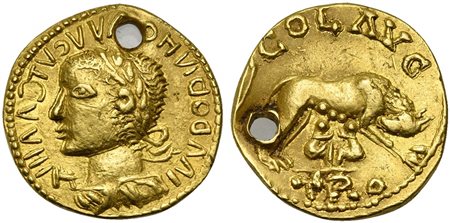 Bertolami Fine Art - Riversdell Close 27, KT16 9JW Chertsey
Bertolami Fine Art - Riversdell Close 27, KT16 9JW Chertsey
Auction 87 - Ancient Coins Seconda sessione
martedì 15 dicembre 2020 ore 14:00 (UTC +00:00)
Uncertain Germanic Tribe, Pseudo-Imperial Aureus struck north of the Danube...
Uncertain Germanic Tribe, Pseudo-Imperial Aureus struck north of the Danube with dies stolen from the mint of Alexandria Troas, after AD 262; AV (g 6,91; mm 19; h 3); Laureate, draped and cuirassed imperial bust l.; around, pseudo-legend, Rv. COL AVG / TRO, she-wolf standing r., suckling the twins Remus and Romulus. Cfr. SNG Copenhagen 161 (for the Alexandrian issue in bronze); Leu Numismatik AG, 4, 25 May 2019, lot 430 (for the second gold Barbaric -Alexandrian typology known).
Of the highest rarity, only 6 specimen known of the entire gold series. Holed, otherwise extremely fine.
Citing from Leu Numismatik AG: "The story of this coin reads like an ancient thriller: It is the year 262, when the inhabitants of Alexandria Troas spot a fleet approaching the Dardanelles from the south. Alarm bells ring and cries of panic fill the streets: "The Goths are here, the Goths are here!". Thousands of Gothic plunderers land on the coast of the Troas, loaded with stolen riches from all over Greece and Asia Minor, and start besieging the wealthy city. Archaeological excavations have shown that the battle-hardened barbarians had no issues penetrating the city walls before they massacred the population and looted the temples and houses. Change of scene to Paris, 1881: the Bibliothèque Nationale acquires a holed Gallienus coin from Alexandria Troas featuring a local motive on the reverse (Lupa Romana) - but to everyone's astonishment, it is minted in gold. The unusual metal and the slightly blundered legends on the obverse lead the numismatists to conclude that this must be a rather curious barbaric imitation. What was it about these 'aurei' from a provincial mint, which was very active under Valerian I and Gallienus but only minted in bronze? It was not until 2017 that a solution to this riddle was proposed, when A. Bursche and K. Myzgin published two further holed 'aurei' of Gallienus from Alexandria Troas. They were able to show that the local provincial mint must have fallen into the hands of the Goths when the city was plundered in 262. When the barbarians returned to their homelands northwest of the Black Sea, they took the stolen coin dies back home with them and began to strike their own coins with the looted gold. The final evidence for their theory was provided in the Paris example, which was struck from a recut obverse die while the reverse corresponds to the provincial coinage from Alexandria Troas: it now became obvious that this was not a mere imitation, but that the coin was struck by the stolen dies from the provincial mint of Alexandria, and that a Gothic artist had, at some point, recut the obverse die due to heavy wear."

